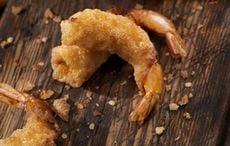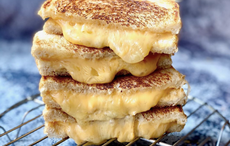Today is back to school day for most kids in this country. It is also my 8th wedding anniversary and as it is payroll day I cannot take the day off and go on the lash with the wife, otherwise we will have 75 very angry cooks roaming the streets of Miami baying for my blood not to mention two kids wondering why their mother didn’t pick them up from school.
So we celebrated yesterday with a nice dinner. I asked her what she wanted and she said “how about a Beef Wellington like we had on our wedding day?”
Now, to be perfectly honest I don’t remember having Beef Wellington on my wedding day or eating anything for that matter as it is all a blur.
The bride and groom don’t actually get to eat much during their wedding dinner, every 10 seconds or so you have a distant cousin or aunt coming over congratulating you so you have to get up and give them a kiss or shake their hand.
-----------------
READ MORE:
The top ten greatest Irish drinking songs - VIDEOS
The top 10 natural wonders of Ireland - SEE PHOTOS
Searching your Irish roots online - Genealogy sites 101
-----------------
We did have cake and champagne when everyone left and thankfully I had a half eaten turkey sub in my apartment so we devoured that when we got home!
So this got me thinking that I haven’t had a Beef Wellington for years, so I set out to make one and find some information about where it came from.
The origin of the name is unclear. There are theories that suggest that beef Wellington is named after Arthur Wellesley, 1st Duke of Wellington. Some theories go a step further and suggest this was due to his love of a dish of beef, truffles, mushrooms, Madeira wine, and pâté cooked in pastry, but there is a noted lack of evidence supporting this.
In addition to the dearth of evidence attaching this dish to the famous Duke, the earliest recorded recipe to bear this name appeared in a 1966 cookbook.
Other accounts simply credit the name to a patriotic chef wanting to give an English name to a variation on the French filet de bœuf en croûte during the Napoleonic Wars. Still another theory is that the dish is not named after the Duke himself, but rather that the finished joint was thought to resemble one of the brown shiny military boots which were named after him.
In introducing a recipe for Beef Wellington, Clarissa Dickson Wright claims "This dish has nothing to do with that splendid hero, the Duke of Wellington; it was invented for a civic reception in Wellington, New Zealand, but it is a splendid addition to any party."
Today, Duxelles might be prepared with other types of mushrooms, instead of Foie gras you might just a liver pate and beef tenderloin might be replaced with pork fillet 3. Even variations with chicken, salmon or lobster are known. As an appetizer, a form of Mini Beef Wellington enjoys some popularity, yet individual Wellington recipes (just one slice of beef) are on the rise.
Ingredients
For the Duxelles:
3 pints (1 1/2 pounds) white button mushrooms
2 shallots, peeled and roughly chopped
4 cloves garlic, peeled and roughly chopped
2 sprigs fresh thyme leaves only
2 tablespoons unsalted butter
2 tablespoons extra-virgin olive oil
Kosher salt and freshly ground black pepper
For the Beef:
1 (3-pound) center cut beef tenderloin (filet mignon), trimmed
Extra-virgin olive oil
Kosher salt and freshly ground black pepper
12 thin slices prosciutto
6 sprigs of fresh thyme, leaves only
2 tablespoons Dijon mustard
Flour, for rolling out puff pastry
1 pound puff pastry, thawed if using frozen
2 large eggs, lightly beaten
1/2 teaspoon coarse sea salt
Minced chives, for garnish
Method
To make the Duxelles: Add mushrooms, shallots, garlic, and thyme to a food processor and pulse until finely chopped. Add butter and olive oil to a large sauté pan and set over medium heat. Add the shallot and mushroom mixture and sauté for 8 to 10 minutes until most of the liquid has evaporated. Season with salt and pepper and set aside to cool.
To prepare the beef: Tie the tenderloin in 4 places so it holds its cylindrical shape while cooking. Drizzle with olive oil, then season with salt and pepper and sear all over, including the ends, in a hot, heavy-based skillet lightly coated with olive oil - about 2 to 3 minutes. Meanwhile set out your prosciutto on a sheet of plastic wrap (plastic needs to be about a foot and a half in length so you can wrap and tie the roast up in it) on top of your cutting board. Shingle the prosciutto so it forms a rectangle that is big enough to encompass the entire filet of beef. Using a rubber spatula cover evenly with a thin layer of duxelles. Season the surface of the duxelles with salt and pepper and sprinkle with fresh thyme leaves. When the beef is seared, remove from heat, cut off twine and smear lightly all over with Dijon mustard. Allow to cool slightly, and then roll up in the duxelles covered prosciutto using the plastic wrap to tie it up nice and tight. Tuck in the ends of the prosciutto as you roll to completely encompass the beef. Roll it up tightly in plastic wrap and twist the ends to seal it completely and hold it in a nice log shape. Set in the refrigerator for 30 minutes to ensure it maintains its shape.
Preheat oven to 425 degrees F.
On a lightly floured surface, roll the puff pastry out to about a 1/4-inch thickness. Depending on the size of your sheets you may have to overlap 2 sheets and press them together. Remove beef from refrigerator and cut off plastic. Set the beef in the center of the pastry and fold over the longer sides, brushing with egg wash to seal. Trim ends if necessary then brush with egg wash and fold over to completely seal the beef - saving ends to use as a decoration on top if desired. Top with coarse sea salt. Place the beef seam side down on a baking sheet.
Brush the top of the pastry with egg wash then make a couple of slits in the top of the pastry using the tip of a paring knife - this creates vents that will allow the steam to escape when cooking. Bake for 40 to 45 minutes until pastry is golden brown and beef registers 125 degrees F on an instant-read thermometer. Remove from oven and rest before cutting into thick slices.
AND FINALLY…
A man and his wife, now in their 60's, were celebrating their 40th wedding anniversary. On their special day a good fairy came to them and said that because they had been so good that each one of them could have one wish.
The wife wished for a trip around the world with her husband. Whoosh! Immediately she had airline/cruise tickets in her hands.
The man wished for a female companion 30 years younger...
Whoosh...immediately he turned ninety!!!
Gotta love that fairy!




Comments